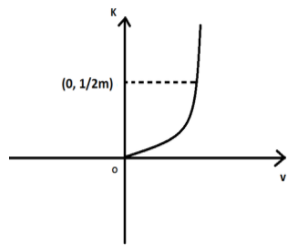
Shape of graph between speed and kinetic energy of a body is-
(A). Hyperbola
(B). Straight Line
(C). Parabola
(D). Circle
Answer
556.8k+ views
Hint: Using the formula for kinetic energy, we determine the relationship between Kinetic energy and speed and analyse the dependent and independent variables out of the two. On the basis of whether the relationship is linear or polynomial we draw a graph and describe its characteristics.
Complete answer:
Speed is the distance travelled by a body in unit time. It’s SI unit is\[{\text{m}}/{\text{s}}\;\] .
\[\text{S = }\dfrac{\text{d}}{\text{t}}\]
Where d= distance traveled by a body in given time
t= time taken
Kinetic energy is the energy possessed by a body due to its motion. It can also be defined as the work required to accelerate a body from its rest position to given velocity. It’s SI unit is joules \[\text{(J)}\].
Kinetic Energy is given by-
\[\text{K = }\dfrac{\text{1}}{\text{2}}\text{m}{{\text{v}}^{\text{2}}}\] - (1)
Velocity varies continuously with time. eq (1) tells us about the relationship between Kinetic energy and speed. From this we can conclude that-
\[\text{K}\propto {{\text{v}}^{\text{2}}}\]
Here, \[\text{(}\dfrac{\text{1}}{\text{2}}\text{m)}\] is a constant.
The graph for a square relationship is a parabola. Eq of Parabola is-
\[{{\text{x}}^{\text{2}}}\text{ = 4ay}\] - (2)
Eq (1) is comparable to eq (2) and the graph will be-

As the square of a variable cannot have negative values, the graph on the negative x-axis is absent.
As there is no intercept, the vertex of the parabola is at origin. Comparing eq (1) and eq (2), we get, \[\text{a = }\dfrac{\text{2}}{\text{m}}\] .Therefore the focus of parabola is at $(0, \dfrac{2}{m})$
Hence, the correct option is (C). Parabola
Note:
Here Kinetic Energy K , is the dependent variable and speed,is the independent variable. Therefore, by convention,K is taken along the y-axis and v is taken along the x-axis. Different parabolas can be formed depending on the axis of symmetry; here the axis of symmetry is the y-axis.
Complete answer:
Speed is the distance travelled by a body in unit time. It’s SI unit is\[{\text{m}}/{\text{s}}\;\] .
\[\text{S = }\dfrac{\text{d}}{\text{t}}\]
Where d= distance traveled by a body in given time
t= time taken
Kinetic energy is the energy possessed by a body due to its motion. It can also be defined as the work required to accelerate a body from its rest position to given velocity. It’s SI unit is joules \[\text{(J)}\].
Kinetic Energy is given by-
\[\text{K = }\dfrac{\text{1}}{\text{2}}\text{m}{{\text{v}}^{\text{2}}}\] - (1)
Velocity varies continuously with time. eq (1) tells us about the relationship between Kinetic energy and speed. From this we can conclude that-
\[\text{K}\propto {{\text{v}}^{\text{2}}}\]
Here, \[\text{(}\dfrac{\text{1}}{\text{2}}\text{m)}\] is a constant.
The graph for a square relationship is a parabola. Eq of Parabola is-
\[{{\text{x}}^{\text{2}}}\text{ = 4ay}\] - (2)
Eq (1) is comparable to eq (2) and the graph will be-

As the square of a variable cannot have negative values, the graph on the negative x-axis is absent.
As there is no intercept, the vertex of the parabola is at origin. Comparing eq (1) and eq (2), we get, \[\text{a = }\dfrac{\text{2}}{\text{m}}\] .Therefore the focus of parabola is at $(0, \dfrac{2}{m})$
Hence, the correct option is (C). Parabola
Note:
Here Kinetic Energy K , is the dependent variable and speed,is the independent variable. Therefore, by convention,K is taken along the y-axis and v is taken along the x-axis. Different parabolas can be formed depending on the axis of symmetry; here the axis of symmetry is the y-axis.
Recently Updated Pages
Master Class 12 Business Studies: Engaging Questions & Answers for Success

Master Class 12 Economics: Engaging Questions & Answers for Success

Master Class 12 English: Engaging Questions & Answers for Success

Master Class 12 Maths: Engaging Questions & Answers for Success

Master Class 12 Social Science: Engaging Questions & Answers for Success

Master Class 12 Chemistry: Engaging Questions & Answers for Success

Trending doubts
What is meant by exothermic and endothermic reactions class 11 chemistry CBSE

Which animal has three hearts class 11 biology CBSE

10 examples of friction in our daily life

One Metric ton is equal to kg A 10000 B 1000 C 100 class 11 physics CBSE

1 Quintal is equal to a 110 kg b 10 kg c 100kg d 1000 class 11 physics CBSE

Difference Between Prokaryotic Cells and Eukaryotic Cells




